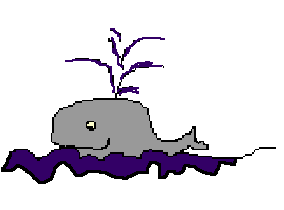 Lesson
Plan #6
Lesson
Plan #6
 Lesson
Plan #6
Lesson
Plan #6
Save Our Oceans !
Duration: 2 to 3 days
Objectives: The
student
will research problems with ocean pollution on the
Internet.
The student will create a banner or poster urging people not to pollute
our world's oceans.
The student will discuss ways in which the ocean habitat is destroyed.
The student will cite examples of how human activity may
produce changes in the
ocean.
The student will identify ways in which pollution can endanger plant life
and
wildlife.
Materials: Background knowledge of causes and effects of ocean pollution.
See web sites listed in procedures.
Any desktop publishing program can be used such as Print Shop
Deluxe
Key Vocabulary: pollutants, environment, ecosystem
Procedures:
1. Have the class brainstorm problems facing our oceans. Have one student write the problems on the board. After the list is complete, have the students pick one topic they would like to research on the Internet.
2. In their research they should answer: What are the sources of this type of marine pollution destruction? What are the effects of this type of marine pollution destruction?
3. The following are sites that are helpful for students to do their research:
Ocean Pollution information about ocean pollution
Oil Pollution all about oil pollution with sources, accidents and cleanups
Dangerous Debris information about how trash kills
Plastics in our Oceans learn about the effects of polluting our waters with plastic
Mining and Dumping learn about the effects of mining and dumping on the seas and land surrounding it
Raw Sewage learn what raw sewage does to people and marine life
Global Warming If the climate changes, what might happen?
Over Fishing Too many people chase too few fish.
Smithsonian Ocean Plant Exhibit Virtual Fieldtrip
4. Review the dangers pollution poses to the delicate ocean ecosystem. List the following pollution problems on the board. Discuss each cause and the long-term effects of continued abuse on our world's oceans. Ask students to consider the pollution they think is the most harmful and most easily rectified.
5. Have them share what they learned while searching the Internet.
6. Have students plan a poster or banner. Have them brainstorm antipollution slogans, either in pairs or individually. They should consider the kind of pollution they wish to target. Their slogans should persuade readers, both graphically and verbally, to stop polluting our world's oceans.
7. Students can use any desktop publishing program to create their poster or banner.
8. Help students edit their posters and banners for spelling errors. Have students print their posters and display them around the school.
Assessment: Students will write letters to the following organizations to find out what action they can take to help the world's oceans. The following rubric will be used for evaluation of letters. Letter Rubric
Cetacean Society
International
P.O. Box
9145
Wethersfield, CT 06109
Cousteau Society
Greenbriar Tower II
870 Greenbriar Circle, Suite 402
Chesapeake, VA 23320
International Whaling Commission
The Red House
135 Station Road
Histon, Cambridge CB4 4NP
England
Home Learning: Have students start collecting newspaper articles or magazine articles related to marine pollution. They will write a brief summary of the articles in their electronic journals. Summaries will be shared in class.
Extension Activity: Students will log onto the following link and complete the activity-
Ocean in a Bottle participate in an ocean in a bottle experiment